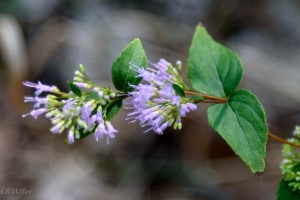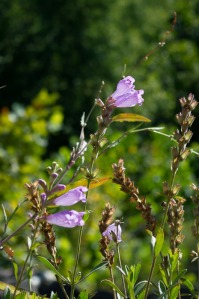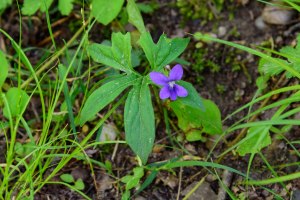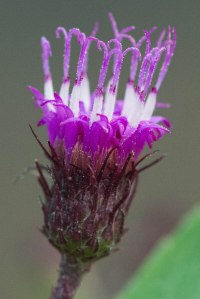As I worked my way along the Potomac River’s muddy banks last week, I watched for New York ironweed (Vernonia noveboracensis; Asteraceae). I hadn’t seen it in the wild in several years. I didn’t find it Monday or Tuesday, but I saw hundreds of plants on Friday. Some were only knee high, others were over seven feet tall; some grew singly, and others grew in huge colonies. Now I appreciate the word “weed” in its name.
 Two (or maybe three, it’s not quite clear) of the 20 or so Vernonia species found in the US are native to Maryland. V. noveboracensis is a wetland species, while V. glauca is an upland species, so the easiest way to distinguish between them is to note where they’re growing.
Two (or maybe three, it’s not quite clear) of the 20 or so Vernonia species found in the US are native to Maryland. V. noveboracensis is a wetland species, while V. glauca is an upland species, so the easiest way to distinguish between them is to note where they’re growing.
One of the neat things about this species is that the inflorescence has only disc florets; there are no ray florets at all.
Joe-pye weed is another tall forb with showy flowers. I see it more often along the C&O Canal than along the river. There are two species found in the Maryland piedmont; this one is Eutrochium fistulosum, which prefers sunny, wet places. The other species (E. purpureum) prefers upland areas. Joe-pye weed is another aster family plant with only disc florets. By themselves they aren’t much to look at; it’s the huge masses of multi-flowered heads in multiple inflorescences that make the plants so showy.
Believe it or not, plants not in the aster family are blooming now, too. These two are in the mallow family (Malvaceae). The white one with the simple leaves is Hibiscus moscheutos (swamp rosemallow); the pinkish ones with the deeply lobed leaves are Hibiscus laevis (halberd-leaved rosemallow). Be wary of using color to tell them apart, as colors in both species can vary, especially in different parts of the country. The leaf shape is a more reliable differentiator.

Swamp rosemallow is common in the coastal plain, less so in the piedmont, and although halberd-leaved rosemallow is on the Maryland DNR watchlist, it seems fairly abundant along the Potomac in Montgomery County.
 Last one for today: Lobelia cardinalis (cardinal flower). I’m always stunned by just how red these flowers are. I’ve never seen a wildflower in this area with such intense color. I was surprised by how common it is: look at the quad map from Maryland Biodiversity Project!
Last one for today: Lobelia cardinalis (cardinal flower). I’m always stunned by just how red these flowers are. I’ve never seen a wildflower in this area with such intense color. I was surprised by how common it is: look at the quad map from Maryland Biodiversity Project!
next time: something new

































